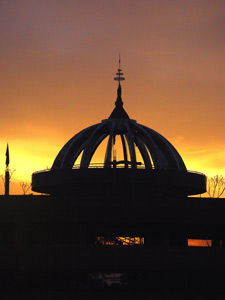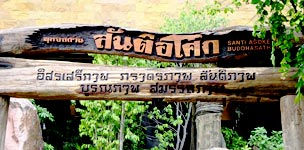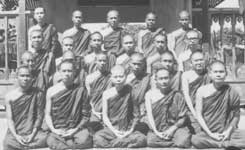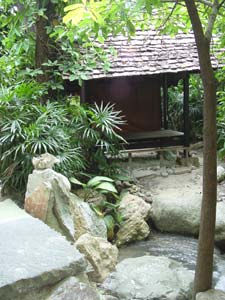 |
Santi Asoke’s History
Buddhasathan Santi Asoke is situated on 7 rais of land at 65/1 Soi Thiamphon, Thanon Nawamin, Khwaeng Klongkum, Khet Buengkum, Bangkok 10240, Tel. 02-374-5230. It is considered to be the headquarters of Asokan people in propagating the Dhamma. It is a production centre for printing media and other forms of mass media to spread the truth as taught by Lord Buddha. It is supported by ‘The Dhamma Santi Foundation’. |
Santi Asoke originated from the point when Mr. Rak Rakphongs, now known as Samana Bhodhirak started strictly practicising the dhamma even while he was still a layman, working as a T.V. programme producer and programme master of ceremony at Chanel 4, BaangKhunPhrom. In his practice he devoted himself to strictly observing the Buddhist precepts, abstained from Apayamook (the vices that lead to hell), abstained from eating meat and became a vegetarian, eating one meal per day. He broke off his engagement with his fiance whom he intended to marry. Finally he resigned from his work, gave away all his assets to his siblings although he was making fast progress in his career and was enjoying great success in material wealth, professional status and fame (he was earning a monthly salary of 20,000 baht while the monthly salary of the Thai prime minister was 12,000 baht. And at that time the theme songs which he wrote for the film ‘Tone’ such as ‘Fah Tam Phaendin Soong’ (Heaven within Reach as Earth may Rise), ChuenRak (So in Love) and KrataiPhue (the Rabbit who yearns for the Moon) also gained much popularity). Having seriously practised the Dhamma with dedication for 2 years until he has succeeded in ridding himself completely of apayamukha (causes of ruin), kàmaguna (sensual pleasures) and loka-dhamma (worldly conditions) that he became certain that he has attained the truth from within himself (patjattang vethitabbho vinyuhi) and certain that real dedication in the practice of dhamma will lead to the realization of the truth (ariyasacca). On November 7, 1970 he was ordained monk by Phra Rajaworakhun in the DhammayutikaNikaya at Wat Asokaram and received the name Bhodirakkhito. Having been ordained as a Buddhist monk he continued to devotedly practise the dhamma and strictly observed the precepts and practised full awareness in all his actions to such an extent that he gained much respect from laypersons as well as monks from both MahaNikaya order and DhammayutikaNikaya order.
However, Phra Rajaworakhun, his ordinator, later refused to allow monks from MahaNikaya order to come and study together with monks in his temple. So on May 2, 1973 Phra Bhodirak became ordained once more as monk in the MahaNikaya order at NongKrathum Temple in NakhonPathom province, without ever having given up his monkhood from DhammayutikaNikaya order. This time his ordinator was PhraKru SathitWutthikhun. The reason for this second ordination was because Phra Bhodirak was less concerned with the different orders but more concerned with the essence of the dhamma. So monks from both orders who practised Samansangwasa (common sanghakamma and common practice) came to study and practise the dhamma with him because they put the focus on the DhammaVinaya itself.
Therefore in order not to create feeling of unease to his ordinator, who was very attached to the order venerable Bhodirak returned the DhammayutikaNikaya’s monk certificate to his ordinator on May 25, 1973 and only retained one monk certificate which is MahaNikaya certificate. But ven.Bhodirak considered himself to belong to both orders and monks from both DhammayutikaNikaya and MahaNikaya orders came to study and practise the dhamma together with him as he never discriminated against any order. He felt it was important to him to be able to propagate the dhamma in public to anyone who was interested to learn and the distinction of the monk order itself did not pose any problem for him as long as the monks obeyed the DhammaVinaya.
On August 6, during a Sangha council meeting at NongKrathum temple, where 180 monks and newly ordained monks were present, ven.Bhodirak and 21 Santi Asoke monks announced their resignation from being under the supervision of The Council of Elders. That announcement of departure from the main group of that time is considered to be “Nanasangwasa” which is a legal tradition according to the DhammaVinaya, giving freedom of practice to Buddhists.
| |
| |  |
Buddha once said that the search for material wealth and the search for nibbana go in opposite directions. There are distinct differences between Asokan monks and the mainstream monks in Thailand. Asokan monks differ from the mainstream monks in their practice (rituals, behaviours and activities). The explanation of the different groups of Buddha’s teachings are also different. More over the direction of study and practice to overcome suffering (Athisila, Athijitta and Athipanya which are the Trisikkha) are almost opposite. It is all these differences put together that brought about the natural development of the status of “Nanasangwasa”. For this reason Asokan monks were obliged to announce the resignation from being under the supervision of the Council of Elders so as to be in keeping with the DhammaVinaya on the Nanasangwasabhumi.
| |
| |
 |
The Asokan Group has constantly been accused of violating the law of the country by resigning from the governance of the Council of Elders. It was claimed that all monks in Thailand were under the governance of the Sangha Act of BE 2505 and that the Asoke monks had no rights to resign from or renounce the governance of the Council of Elders. This claim further quoted the Constitution of the Kingdom of Thailand which stipulated that it was the duty of all Thai citizens to obey the law. And since no exceptions to this rule was stipulated in the Act it then followed that the Asoke monks’ resignation from being under the governance of The Council of Elders was not valid. This interpretation of the law was without principle. The Sangha Act of BE 2505 is a law with penalties. So it is a criminal law and therefore the interpretation of this law must be done strictly in accordance with clause 2 of the Criminal Code and should not contradict the Constitution of the Kingdom of Thailand which was the governing law of Thailand at that time. The Sangha Act of BE 2505 is a substantive law regulating the contents of rights and duties of the people and its interpretation has to be done according to the principle of ‘no offence nor punishment without law’ which corresponds with Clause 2 of The Criminal Code which stipulates that “a person shall only receive criminal punishment for any act which, at the time when it was committed, national law constitutes as a criminal offense with penalty. Punishment issued to offenders can only be punishment that was stated by law”. Since it was not stated anywhere in the Sangha Act of BE 2505 that it was prohibited to declare secession from the administration of the Council of Elders, it then follows that such action taken by the Asokan samanas was not a criminal offence. Not only does this action not contradict with the DhammaVinaya regarding “nanasangwasa”, it in fact is in accordance with Article 25 of the Constitution of The Kingdom of Thailand B.E. 2521. which reads as follows:
“A person shall enjoy full liberty to profess a religion, a religious sect or creed, and observe religious doctrine or exercise a form of worship in accordance with his or her belief; provided that it is not contrary to his or her civic duties, public order or good morals.
In exercising the liberty referred to in paragraph a person is protected from any act of the State which deprives him or her of his or her lawful rights and due benefits on the grounds of professing a religion, a religious sect, creed or order or observing religious doctrine or precepts or exercising a form of worship in accordance with his or her belief which is different from that of others.”
Therefore the Asokan group of Samanas should have the right of protection by the State according to Article 25 of The Constitution of The Kingdom of Thailand. Furthermore it is not stated anywhere in the Constitution that the act of secession from the rule of The Council of Elders is a criminal offence and there is no penalty stated for such action. So the announcement by the Asokan group of Samanas to secede from the rule of the Council of Elders is permissible and is also in accordance with the DhammaVinaya regarding the Nanasangwasa discipline which , in recognizing fully the human rights and respecting the freedom of choice, allows monks to conduct the Ubosoth and Sangkagamma peacefully and separately where opinions and practices of the two groups of monks differ so radically that it is no longer possible to conduct such activities together in harmony.
As a summary, Santi Asoke came into being by its own natural way. There was never any intention to form a new religious sect or order. It all started when seriously studied the dhamma and strictly observed the precepts until he found the ariyasacca dhamma. He then became ordained as a monk in the DhammayutikaNikaya but was met with unacceptance by his ordinator when he started teaching the dhamma to monks from a different order due to the latter’s attachment to his own order. Therefore Phra Bodhirak became ordained once more in the MahaNikaya so he could teach monks from both orders. Nevertheless, the existence of various real major differences between Phra Bhodirak’s and his followers’ practices and those of the other monks living in the same temple led inevitably to disharmony within that sangha community.
Consequently the Asokan monks were obliged to secede from the main group of monks and live under the discipline of Nanasangwasa as permitted by The Buddha himself as stated in the DhammaVinaya. This secession also complies with the Constitution of The Kingdom of Thailand which says that a person shall enjoy full liberty to profess a religion, a religious sect or creed, and observe religious doctrine or exercise a form of worship in accordance with his or her belief even if it differs from the others’.
|
| | |
 |
The birth of the Asokan monks actually came about as a result of the monks from both DhammayutikaNikaya and MahaNikaya coming to study and practise the dhamma together. The spirit of acceptance and non discrimination against sect or order which is the starting point of the Asokan monks continues to this day. Asokan Samanas respect and welcome monks from any sect or order to come and live and practise the dhamma together for mutual growth and development provided they observe the 227 Vinaya and profess the Julasila, Machimasila and Mahasila which is the religious equivalent of The Kingdom’s Constitution for Buddist monks.
Thai language |